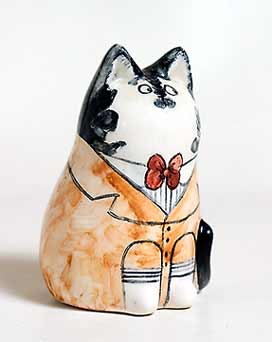
A business card from the early 1930s


Joan and David de Bethel started making papier maché cats and bears in 1960. They were intricately made and quite expensive - each piece took at least a day just to paint.
David died in 1977 and Joan took up an idea that they had been tossing around before his death; she got Rye Pottery to supply soft biscuit fired models, and she painted them and returned them to the pottery for the glaze firing. Many failures ensued as the ceramic paint smudges easily when dry and this made successful transportation of the pieces difficult.
Demand was high, and Joan had to go to Cinque Ports Pottery to augment the supply of bisque blanks. During a period of exceptionally high demand the Cinque Ports decorators had to help out by painting some pieces, and this led to Joan allowing Cinque Ports to produce their own models, very similar to hers. A change in the production technique followed. Instead of soft biscuit fired blanks Joan used hard fired biscuit and painted it with acrylic paint, finishing it off in marine varnish, eliminating the need for a further firing and the problem of smudging.
Items marked with the Cinque Ports backstamp and From a design by Joan de Bethel are wholly the work of Cinque Ports Pottery. Those marked JB © Rye are painted by Joan and glazed and fired by Cinque Ports. The models marked Joan de Bethel or Joan and David de Bethel are hand-painted and cold glazed (marine varnished) by Joan. All the papier maché items, of course, however marked, were hand made and decorated by Joan.
Following the demise of the Cinque Ports Pottery in July 2007 production of the blanks has moved to the David Sharp Pottery where Ben Sharp is carrying on with exactly the same arrangement that Joan had with Cinque Ports.
There is a strong collectors' market for de Bethel pieces. The ceramic ones fetch good prices and the papier maché originals realize very high prices. For someone who has not handled both types it is difficult to tell the ceramic and the papier maché apart - the papier maché are very hard and quite heavy - it's quite simple though; the papier maché models are solid at the base and the pottery ones are hollow. Similarly the Cinque Ports pieces are easy to tell from de Bethel's by the mark on the base. The pottery cats come in different sizes, the largest being about 7 inches (178mm) high.
Joan de Bethal has also been a designer for Rye Pottery, and is a respected painter of pictures.
Further Reading: | The Potteries of Rye, 1793 onwards by Carol Cashmore |
The name 'Rye Pottery' can be applied to ceramics produced in the small Sussex town of Rye and the surrounding area.
Pottery has been produced in Rye since mediaeval times, but what is now known as Rye pottery was started at Cadborough near the end of the eighteenth century. Cadborough established the design that is now recognized as traditional for Rye pottery - applied sprigs of hops and hop leaves on pots made from local clay with a lead glaze.
In the second half of the nineteenth century the Bellevue Pottery opened In Rye, and by 1890 the Cadborough Pottery had run out of family members to keep it going, and was swallowed by the thriving Bellvue Pottery. Bellvue was run by Frederick Mitchell until his death in 1875 and by his wife, Caroline, until Frederick Thomas Mitchell, their son, took over in the last decade of the nineteenth century.
After the turn of the nineteenth century the company ventured into more ambitious styles, including lustre glazes.

A business card from the early 1930s
By the 20's and 30s they were producing the Jazz and Deco designs that were popular at the time. The pottery was owned by Edith Mitchell, Frederick's widow, from 1920 to 1930 and by Ella Mills from then to the outbreak of the second World War. During the tenure of these two ladies the pottery's name changed several times, being variously known as Rye Art Pottery, Sussex Art Pottery, Sussex Rustic Ware and Sussex Art Ware. After the outbreak of the Second World War the pottery had to close down due to wartime restrictions on kilns being fired during the hours of darkness.
After the war the premises were bought by two young sculptors - the brothers Wally and Jack Cole, who renamed the company 'Rye Pottery'. They moved away from the traditional designs and produced high quality majolica in the styles of the fifties. They trained many apprentices, and most of them eventually left to set up their own potteries in Rye. At one time there were no less than eight individual potteries in the tiny town, making it an important centre for the trade.
One of those apprentices, David Sharp (b1932-d1993), was to become a leading figure with a large following of collectors. He made very varied and original designs, some of which were quite controversial. The David Sharp Pottery continues today, run by his family and making good pieces in interesting designs. A well known activity of the pottery is the making of number or name plaques for houses, usually circular or oval, that are a distinctive feature of most of the houses in Rye and are shipped to all corners of the world.
Denis Townsend is also an ex-Rye Pottery apprentice. He is know for work of very high quality, and his company, Iden Pottery, produced domestic wares for some of the most select retailers throughout the world.
There is an active collectors' club devoted to Rye Pottery - The Potteries of Rye Society. If you are interested in joining, call Barry Buckton on +44 (0)1233 647898, or contact us at the Pottery Studio and we will pass your details on to Barry.
Further Reading: |
The Potteries of Rye, 1793 onwards by Carol Cashmore |